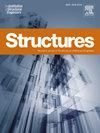胶结砂砾材料裂缝识别及时空分布规律研究
IF 4.3
2区 工程技术
Q1 ENGINEERING, CIVIL
引用次数: 0
摘要
为研究胶结砂砾材料的裂纹发育演化特征及损伤破坏机制,对不同骨料级配和水胶比的胶结砂砾材料进行单轴压缩试验,并利用声发射(AE)系统对胶结砂砾材料的损伤过程进行监测。采用RA-AF和GMM方法综合识别相应的裂纹发展机制,建立CSG材料的中尺度离散元模型,并嵌入矩张量理论模拟声发射过程,进一步定量描述CSG材料的损伤机理。结果表明:骨料级配和水灰比对CSG材料的应力-应变曲线和抗压强度有显著影响,不同骨料级配存在不同的最佳水灰比;根据声发射参数特征将损伤过程划分为4个阶段;初始裂纹闭合、新裂纹扩展、裂纹合并和峰后损伤;CSG材料的裂纹起裂、扩展和聚并过程发生在峰值应力之前,裂纹空间分布以分散为主,小裂纹分布稀疏,大裂纹分布密集;数值模拟加载过程中,骨料周围界面裂缝表现为相对滑移和挤压运动,细观尺度上以剪切和混合模式裂缝的扩展为主,最终导致骨料与水泥之间的粘结力丧失和材料的破坏。研究结果弥补了CSG材料中尺度机理研究的不足,为CSG材料的应用提供了理论支持。本文章由计算机程序翻译,如有差异,请以英文原文为准。
Study on the investigation of cracks identification and spatio-temporal distribution law in cemented sand and gravel materials
To interpret the crack development and evolution characteristics and damage failure mechanism of cemented sand and gravel (CSG) material,uniaxial compression tests were carried out on CSG with different aggregate gradations and water-binder ratios, and the damage process of CSG material was monitored using an acoustic emission (AE) system. The RA-AF and GMM methods were used to comprehensively identify the corresponding crack development mechanisms, while a mesoscale discrete element model of CSG material was established and embedded in the moment tensor theory to simulate the AE process, which further quantitatively describes the damage mechanism of CSG material. The results show that aggregate gradation and water cement ratio have a significant effect on the stress-strain curve and compressive strength of CSG material, and different optimal water cement ratios exist for different aggregate gradations; the damage process is divided into four stages by the characteristics of AE parameters; initial crack closure, new crack expansion, crack coalescence and post-peak damage; the crack initiation, expansion and coalescence processes of CSG material occur before the peak stress, and the crack spatial distribution is mainly decentralized, with sparse distribution of small cracks and dense distribution of large cracks; The GMM crack classification results show tensile cracking at high water-cement ratio and mixed tensile-shear cracking at low water-cement ratio;;during the loading process of numerical simulation, the interfacial cracks around the aggregate show relative slip and extrusion motions, and the expansion of shear and mixed-mode cracks predominates at mesoscale, which ultimately leads to the loss of cohesion between aggregate and cement and the destruction of the material. The results of the study make up for the lack of CSG material mesoscale mechanism study and provide theoretical support for CSG material application.
求助全文
通过发布文献求助,成功后即可免费获取论文全文。
去求助
来源期刊

Structures
Engineering-Architecture
CiteScore
5.70
自引率
17.10%
发文量
1187
期刊介绍:
Structures aims to publish internationally-leading research across the full breadth of structural engineering. Papers for Structures are particularly welcome in which high-quality research will benefit from wide readership of academics and practitioners such that not only high citation rates but also tangible industrial-related pathways to impact are achieved.
 求助内容:
求助内容: 应助结果提醒方式:
应助结果提醒方式:


